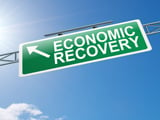 We interrupt this broadcast to bring you important news: the U.S. economy is still growing—and faster than many expected.
We interrupt this broadcast to bring you important news: the U.S. economy is still growing—and faster than many expected.
I hesitate to highlight this, as I fear I'm starting to come off as a perennial optimist, even a cheerleader, for the economy. But it’s important to consult the data, good and bad alike, and there have been plenty of positive developments lately.
The latest round of good news
U.S. economic growth for the third quarter was revised upward this morning to 3.9 percent from 3.5 percent, which doesn’t sound like all that big a deal. But not only was this an upward revision from an already strong number, the actual figure came in above the high end of expectations—not just stronger, but stronger than anyone had expected. Most forecasters had predicted that GDP growth would be revised down, so this is an even bigger surprise than it might seem.
The higher growth came from faster consumer spending, up from 1.8 percent to 2.2 percent, and significantly higher business investment, up from 5.5 percent to 7.1 percent. These gains bode well for continued strength in the fourth quarter. Meanwhile, negative adjustments came from lower-than-expected net exports (which makes sense given weakness elsewhere in the world) and a smaller inventory adjustment.
And the not-so-good news
The big disappointment was the growth rate for worker compensation (a major worry area for the economy going forward), which was adjusted down quite a bit. And the decline in consumer confidence reported today exacerbates that concern. Wage growth and anemic consumer spending remain the principal challenges the U.S. economy will face over the next year.
But despite the discouraging numbers in these areas, the overall trends are good:
- Initial jobless claims remain at very low levels.
- The unemployment rate continues to decline.
- Gasoline prices have seen a significant drop to a near four-year low.
All of these factors should prime the American consumer to spend. It's also worth noting that, despite the weak consumer confidence number reported today by the Conference Board, the other major survey, from the University of Michigan, posted an eight-year high.
Solid domestic growth
Economic data is noisy and subject to revision, and no one data point tells the whole story, including the encouraging economic growth number. Instead, we have to look at changes and trends over time. Almost all of these are encouraging and improving. Even those that are weak (such as wage growth) are showing more signs of improvement than is generally accepted.
Today’s positive growth revision is one more indication that the economy really is recovering, and that the recovery is starting to accelerate. I consider this number especially relevant because it survived the decline in net exports, suggesting that domestic growth is solid enough to endure further weakness elsewhere in the world, which is likely on its way.
Once again, we have many reasons to be thankful. Happy Thanksgiving week!


 Print
Print

